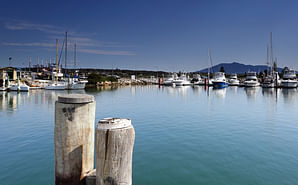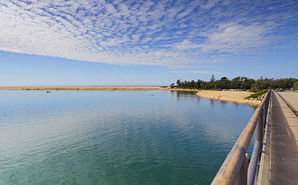Special Rate Variation
Council has adopted the Special Rate Variation that will take effect from 1 July 2023.

Council's SRV Decision
Council has approved and adopted the permanent Special Rate Variation (SRV) of 24% inclusive of the 4.1% rate peg for the 2023-24 financial year and 19.6% inclusive of an assumed 2.5% rate peg for the 2024-25 financial year. The SRV will take effect from 1 July 2023 for all rateable properties in the shire. Ratepayers are encouraged to assess the impact of the SRV on their respective properties by using the SRV calculator.
IPART Determination
The Independent Pricing and Regulatory Tribunal (IPART) has approved Bega Valley Shire Council’s application for a permanent Special Rate Variation (SRV) of 24% in 2023-24 and 19.6% in 2024-25. Councillors will carefully consider the implications of the determination and assess whether to proceed with the SRV at the 28 June Council meeting.
Should Councillors choose to proceed with the rate increase, it will be effective from 1 July 2023.
- 15 June 2023 - Media Release: IPART decision on special rate variation
- 15 June 2023 - IPART Media Release: Decision on 17 Council Special Variation Appliations
- IPART Determination - Bega Valley Shire Council
Council's SRV application
Council’s updated Long Term Financial Plan outlined that a 90% increase in rates would be required to maintain existing levels of service. Acknowledging the extensive feedback received during the community engagement period, along with recent successful grant funding and the independently assessed Capacity to Pay Report, Council officers recommended at the 1 February 2023 Council meeting to proceed with a permanent special rate variation of 43% as per Option C in the updated Long Term Financial Plan 2023-32.
Councillors supported the 43% increase, however requested it be introduced over two years further acknowledging the economic stresses the community is experiencing. This increase is modelled as Option E in the updated LTFP.
Council has submitted an SRV application to IPART for a permanent special rate variation of 24% in 2023-24 (inclusive of 4.1% rate peg) and 19.6% in 2024-25, (inclusive of assumed 2.5% rate peg). By resolving to split the recommended 43% increase over two years it results in a cumulative increase of 48.3% at the end of 2024-25.
Background
To meet the rising costs of delivering services and maintaining and renewing our community assets, Bega Valley Shire Council has applied for a permanent Special Rate Variation (SRV).
SRVs allow a council to increase its income from rates above the ‘rate peg’ (the annual increase set by the Independent Pricing and Regulatory Tribunal each year), under the provisions of the Local Government Act 1993 (NSW).
Every day our expenses are rising beyond our income and we need to either increase our income or significantly reduce the services and assets we provide across our whole community.
We are a geographically large shire with a relatively small number of ratepayers. We also have vast areas of state and national parks and forests which don’t generate income.
This means we need more money to look after our assets into the future – things like roads, footpaths, bridges, stormwater drains, parks, libraries, community buildings and swimming pools – and the vital services we provide to the community, including:
- manage our sporting fields, parks, playgrounds, swimming pools, community halls and cemeteries
- ensure our road, bridge and footpath networks are safe and accessible
- operate our libraries, Regional Gallery, Civic Centre, Regional Learning Centre and childcare services
- process development applications
- conserve and rehabilitate our natural environment
- keep our community healthy and safe by providing rangers, building inspectors and health inspectors
- support our community and repair infrastructure when impacted by disasters.
Key points that are important to understand:
- The SRV would only be applied to the base rate and the ad valorem component of your rates bill, not your entire bill. The ad valorem is related to the unimproved land value of the property and is calculated from property valuations supplied by the NSW Valuer General. The SRV will not be applied to any waste, water or sewer charges on your rates notice.
- The Independent Pricing and Regulatory Tribunal (IPART) will decide whether to approve or deny our SRV application. If we apply, there is a chance we will not get approval.
- If we do get approval, the SRV will not be introduced until 1 July 2023.
Why do we need an SRV?
The funding of local government is complex. The work we do is largely funded by general rates and charges, user fees and charges and a Financial Assistance Grant from the Australian Government. We also receive grants from the state and Australian government for certain projects, programs and services.
In the past, councils received close to 1% of federal taxation revenue through the Financial Assistance Grants. However over time this has reduced to 0.55%, with no indication this declining trend will change.
Our fixed income base is from general rates (the base rate and ad valorem) and this is set each year by the rate peg controlled by the Independent Pricing and Regulatory Tribunal (IPART).
Over the years, the annual rate peg increases have not kept pace with the inflation and rising costs. Our delivery costs have increased significantly – fuelling our vehicles to repair roads, clean toilets, mow lawns, pay wages, etc – and the costs involved in purchasing materials, hiring contractors and paying suppliers has also increased.
Council has worked hard to make sure we are as efficient as possible and we continue to review ways to reduce expenditure including staff restructures, improvements in our asset management processes, zero-based budgeting, divestment of land and joint regionalisation of services and planning.
We have continued to deliver grant-funded assets to increase liveability and amenity in our community and this, combined with external influences such as rising costs, material shortages and unexpected expenditure associated with multiple disasters and the pandemic, has gradually led to the problem we now seek to address.
If we don’t improve our financial position over the longer term, services will have to be reduced and assets will not be renewed when needed. The value of our cash and investments will continue to decline.
The gap between the increasing cost to support our assets and deliver services, and the fixed amount of income we collect is widening, so applying for an SRV now is a financially responsible decision.
The Long Term Financial Plan (LTFP) that was adopted by Council in June 2022 was based on financial modelling assumptions and estimates from March and April 2022. Since that time, we have experienced rapidly rising inflation, ongoing cost escalations, material and contractor supply issues and undertaken further revaluation of our assets.
At the time of adopting the current LTFP, it was also acknowledged that costs for renewing or rebuilding assets had been based on unit rates that were backwards looking and were expected to be underestimates based on inflationary trends at that time. In addition, further detailed work was done on understanding what our asset replacements needs are over the next 10 years. In the next 10-year period, there is a need to replace a number of large value assets that are at the end of their lives and have not yet been replaced. Many of the large value assets Council manages are long lasting assets such as pools and bridges that have 50-70 year lives. Many of our assets were built in the 1940s, 50s and 60s and are now nearing the end of their service lives and if they are not replaced, risk failure and closure.
Frequently Asked Questions
A special rate variation (SRV) allows a council to increase its income base from rates above the rate peg, under the provisions of the Local Government Act 1993 (NSW). An SRV is a tool used by councils to adjust their fixed income base. SRVs can be for one or several years and can be temporary or permanently retained in the rates base. SRVs only apply to your general rates (base rate and ad valorem). It does not apply to water, sewer or waste charges.
The ‘rate peg’ applies to the overall amount by which a council can increase its general rates income and doesn’t necessarily mean the same change will be experienced by every rateable property. The ‘rate peg’ is intended to reflect the cost to councils in providing their services to communities. However, it is a ‘reflective’ model – this means each year, IPART looks back at what typical items a council might purchase – they call it the ‘basket of goods’ – and what they would cost and estimates a reasonable increase. The model doesn’t project forward, so rate increases have not kept pace with inflation and rising costs over many years. The ‘basket of goods’ IPART uses to determine indexation in local government does not accurately reflect what drives our costs.
This year is the first time that the ‘rate peg’ also includes a population growth factor. The standard ‘rate peg’ for 2023-24 is 3.7%. Based on the Bega Valley Shire’s population growth factor, our total rate peg amount for 2023-24 will be 4.1%.
Despite the recent inclusion of the population growth factor, for many years the ‘rate peg’ has not kept pace with the financial needs of councils in NSW and residents’ needs for appropriate services. This has been acknowledged by the Minister for Local Government who has requested that the existing rate peg methodology be reviewed.
Council has resolved to proceed with a 24% SRV in 2023-24 and 19.6% SRV in 2024-25 permanently applied, inclusive of 4.1% rate peg (FY2023-24) and 2.5% rate peg (FY2024-25). This SRV will allow Council to:
- prioritise catching up on our infrastructure backlog in 2023-24 and 2024-25, noting a planned reduction in the capital program below recommended levels to meet our current asset management needs after this time.
- partially fund to required levels the ongoing operation, maintenance and renewal of existing assets
- Improve, although not resolve, Council’s financial sustainability
Council has a range of existing special variations in place to supplement the cost of existing services provided to the community including biosecurity, tourism, lifeguards, the regional gallery and the airport. The last SRV Council applied for was in 2013 to provide funding for collector roads, recreation facilities, public halls and buildings.
We are one of many NSW councils facing financial sustainability challenges. For the 2020-21 financial year, 74 (of 128) councils reported operating deficits in their general fund.
There are 15 Councils who have notified IPART of their intent to apply for an SRV. More information is available on the IPART website.
The value of each property is used as the basis for calculating what each property owner will pay. Land value is based on the unimproved value - to make it fair for all our ratepayers. The Valuer General oversees the valuation system and values all parcels of land in NSW and is currently undertaking a revaluation across the Bega Valley.
Council will not be in receipt of the updated land valuations data from the Valuer General until early 2023. We have been advised by the Valuer General that mailout of the new valuations for residents in the Bega Valley won’t commence until April 2023
It is important to note that Council does not receive any extra income when property values increase, it just changes how the total general rates income we can collect is distributed across all ratepayers.
Inflation has been driving up our costs faster and more steeply than we could have anticipated. Inflation is outside our control and is driven by several things including multiple disasters, COVID-19 pressures, supply chains, government stimulus spending, trade challenges with China and the war in Ukraine.
Inflation has been driving up our costs faster and more steeply than we could have anticipated. Inflation is outside our control and is driven by several things including multiple disasters, COVID-19 pressures, supply chains, government stimulus spending, trade challenges with China and the war in Ukraine.
Each year, councils wishing to apply for an SRV apply to the Independent Pricing and Regulatory Tribunal (IPART) in February. The applications are assessed against criteria listed in the Office of Local Government’s Guidelines. These include:
- The need for, and purpose of, a different revenue path for the council’s General Fund (as requested through the special variation) is clearly articulated and identified in the council’s Integrated Planning and Reporting (IP&R) documents
- Evidence that the community is aware of the need for and extent of a rate rise
- The impact on affected ratepayers must be reasonable
- The relevant IP&R documents must be exhibited (where required), approved and adopted by the council
- The IP&R documents or the council’s application must explain and quantify the productivity improvements and cost containment strategies
- Any other matters
IPART will undertake their independent assessment and if approved, the SRV will be included in the 2023-24 financial year budget. Decisions on what council delivers within the approved rate increase will need to be made. If an SRV is not approved by IPART, the rate peg increase of 4.1% will still be applied to general rates.
Council is very conscious of the hardship that an SRV might cause and has recently reviewed and adopted its Financial Hardship Assistance Procedure. To view the policy visit Public Policies and search for the term 'financial hardship'.
You can learn more about how rates are calculated here.
Rate calculator
The rates calculator is based on the 2022 land valuations data, to calculate the impact on your rates of the Special Rate Variation.
Related information
- 29 June 2023 - Media Release - Councillors agree to Special Rate Variation and adopt Annual Budget 2023-24
- 28 June 2023 - Adopted Long Term Financial Plan 2023-32
- 15 June 2023 - Media Release: IPART decision on special rate variation
- 15 June 2023 - IPART Media Release: Decision on 17 Council Special Variation Appliations
- June 2023 - LG Determination - Bega Valley Shire Council - Special variation application 2023-24
- 13 June 2023 - Instrument - 2023-24 - Bega Valley Shire Council - Special Rate Variation
- 2 February 2023 - Media Release
- Council Report 1 February 2023 - 10.1. Special Rate Variation- Decision to apply to IPART
- February 2023 - Updated Long Term Financial Plan 2023-32
- SRV Information flyer to ratepayers
- Frequently asked questions
- Media Release 17 November 2022
- Council Report 16 November 2022
- Special Rate Variation 2022 Community Presentation
- How land revaluations impact your rates
Radio interviews:
- ABC South East breakfast radio interview with Bega Valley Shire Council Chief Executive OfficerAnthony McMahon - 16 February 2023
- ABC South East breakfast radio interview with Bega Valley Shire Council Chief Executive Officer, Anthony McMahon - December 2022
- 2EC radio interview with Bega Valley Shire Council Chief Executive Officer, Anthony McMahon - 6 December 2022.
Video: Special Rate Variation - Online community meeting - December 2022
Who's listening
Kaliegh Smerdon
Manager, Corporate Planning and Improvement
Bega Valley Shire Council
Phone: (02) 6499 2430
Email: KSmerdon@begavalley.nsw.gov.au
Keen to stay updated on the SRV conversation?
SRV Update back issues
Timeline of works
-
May to June 2022
Community engagement on Council’s Integrated Planning and Reporting documents, including the potential introduction of an SRV.
-
June to September 2022
Council review of SRV options and efficiency measures.
-
16 November 2022 to 16 January 2023
Community engagement
- Have Your Say feedback and survey
- Local markets and community events
- Town hall meetings
- Online meeting- 25 November 2022
Council required to notify IPART of its intention to apply for an SRV.
- 25 November 2022
-
1 February 2023
Council resolved to apply for an SRV.
-
3 February 2023
Council submitted an application for an SRV to IPART.
-
February/March 2023
Community members can make a formal submission on the proposed SRV directly to IPART.
-
April 2023
19 April 2023 - Community Engagement commences
There are 28 days to have 'Your Say' and comment on the 2023-24 planning documents. -
May 2023
17 May 2023 - Community engagement concludes
We will review your feedback before adopting the 2023-24 planning documents. You can review a consolidated report of all feedback received at the Council meeting on 14 June 2023. -
June 2023
IPART advises Council of its determination.
- 28 June 2023 - Adoption of 2023-24 planning documents
Once the plans are adopted, we will publish them on our website and get to work implementing them.
- 28 June 2023 - Adoption of 2023-24 planning documents
-
1 July 2023
If approved, an SRV is applied to general rates.
News and Updates






